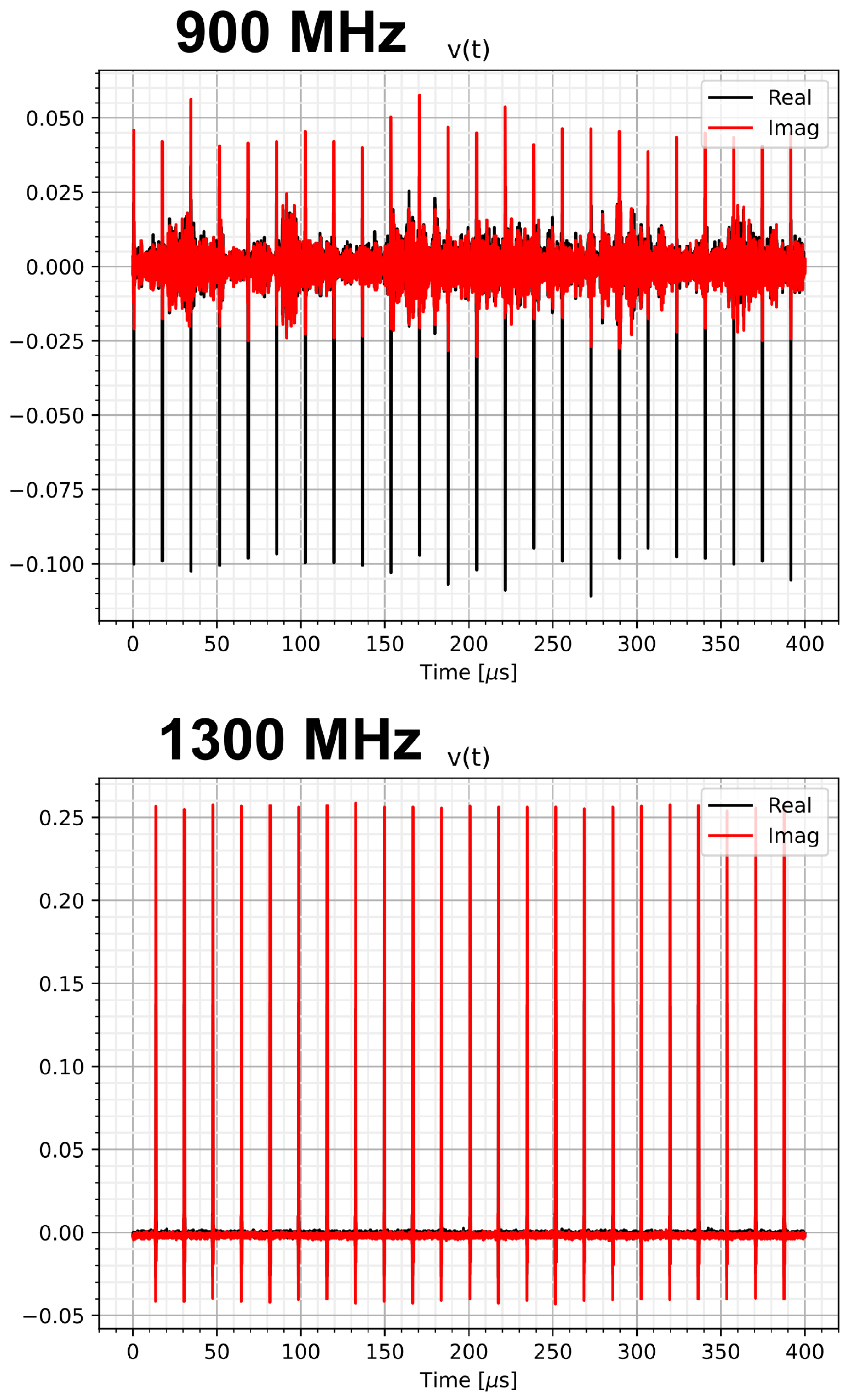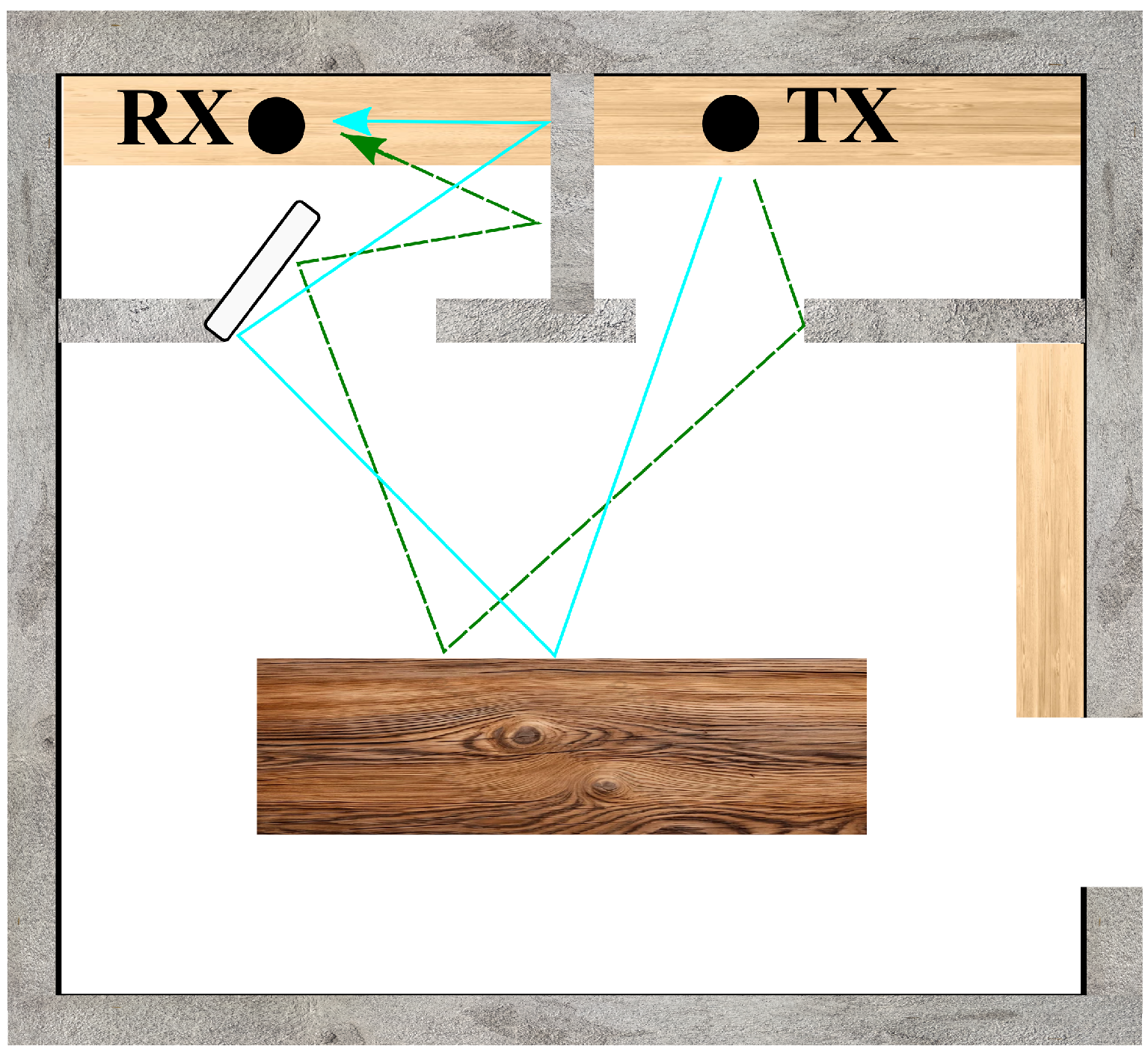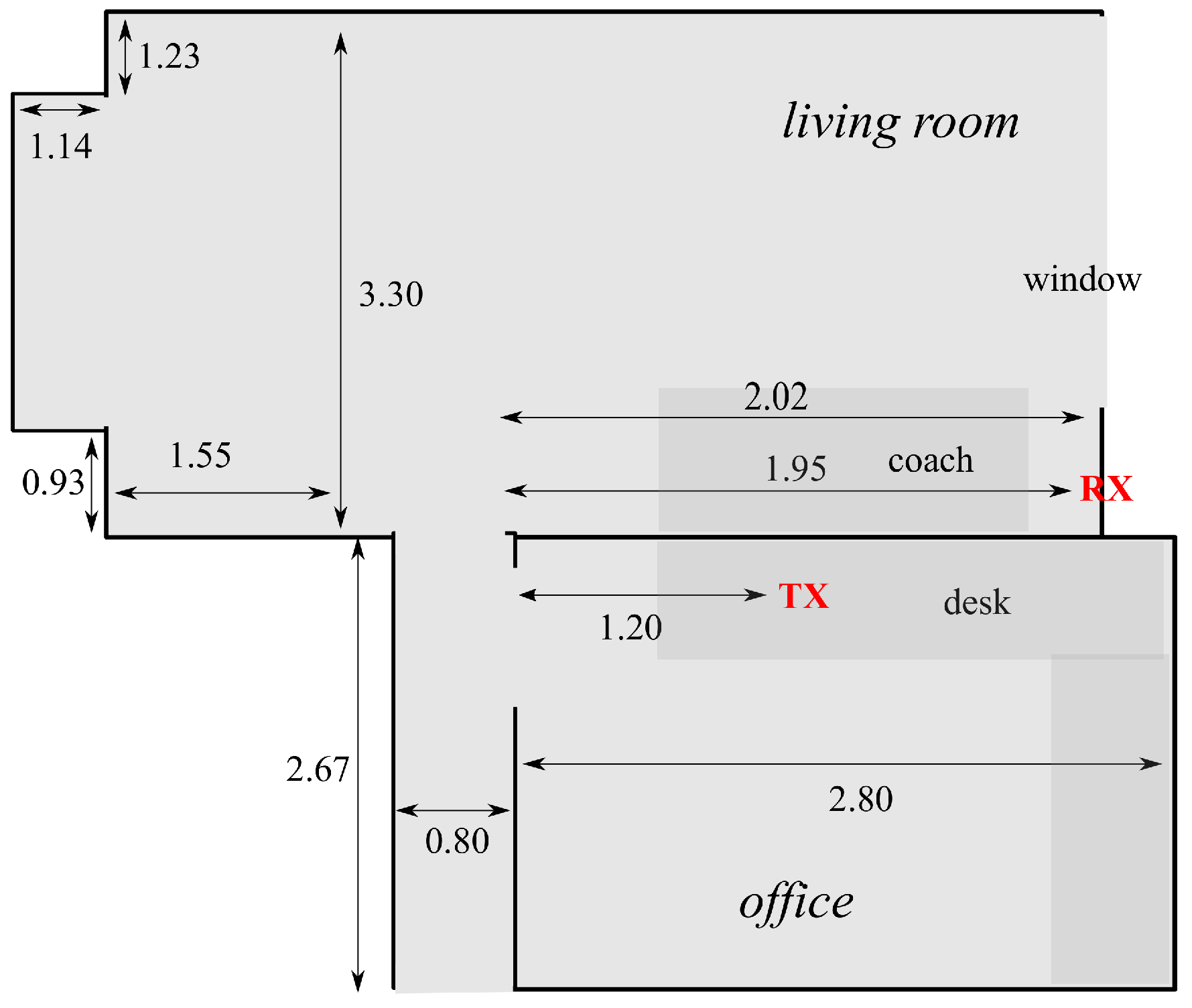Time Reversal Technique Experiments with a Software-Defined Radio
Abstract
1. Introduction
- Training: where a signal occupying the desired bandwidth B is transmitted and captured by the receiver, which in response develops a signal at its input, which is digitally recorded for the next step.
- TR: the received waveform is phase conjugated in the frequency domain, , and retransmitted by the TX antenna. In the receiver, a signal develops on its terminals, which is expected to have a larger energy than the original . The relation between the amplitude of both signals is the gain parameter which expresses the advantage of the TR technique.
- Lower costs when compared with complex instrumentation like AWGs and VNAs.
- Open-source solutions to software control and integration.
- The software control interface has several built-in tools that help the TR flow design, such as filters, fast Fourier transform (FFT), decimators, etc.
- The seamless integration of software and hardware that enables a quick deployment of modifications, for instance, testing different frequencies, amplifier gains, and transmitted power amplitudes.
- In case SDRs with two MIMO ports are employed, a complex signal is able to be retrieved (IQ samples), with information on the phase.
- Lighter and with smaller dimensions.
2. Materials and Methods
2.1. Hardware


2.2. Software
3. SDR Output Investigation
4. Results
4.1. Domestic Environment: Sweeping Frequency
4.2. Laboratory Environment: Computing the Gain for Different Positions


4.3. Gain for One Position and Addressing the Focusing at Other Untrained Points
5. Conclusions
Author Contributions
Funding
Data Availability Statement
Conflicts of Interest
References
- Fink, M. Time Reversal of Ultrasonic Fields-Part Basic Principles. IEEE Trans. Ultrason. Ferroelectr. Freq. Control 1992, 39, 555–588. [Google Scholar] [CrossRef] [PubMed]
- Lerosey, G.; de Rosny, J.; Tourin, A.; Derode, A.; Montaldo, G.; Fink, M. Time reversal of electromagnetic waves. Phys. Rev. Lett. 2004, 92, 193904. [Google Scholar] [CrossRef]
- Wu, F.; Fink, M. Time reversal of ultrasonic fields Part II: Experimental results. IEEE Trans. Ultrason. Ferroelectr. Freq. Control. 1992, 39, 567–578. [Google Scholar] [CrossRef]
- Sarkar, T.K.; Palma, M.S. Electromagnetic Time Reversal: What does it Imply? In Proceedings of the 2016 URSI International Symposium on Electromagnetic Theory (EMTS), Espoo, Finland, 14–18 August 2016. [Google Scholar]
- Santos, V.R.N.; Teixeira, F.L. Application of time-reversal-based processing techniques to enhance detection of GPR targets. J. Appl. Geophys. 2017, 146, 80–94. [Google Scholar] [CrossRef]
- Fusco, V.; Buchanan, N. Developments in retrodirective array technology. IET Microw. Antennas Propag. 2013, 7, 131–140. [Google Scholar] [CrossRef]
- Khaleghi, A. Measurement and analysis of ultra-wideband time reversal for indoor propagation channels. Wirel. Pers. Commun. 2010, 54, 307–320. [Google Scholar] [CrossRef]
- Ibrahim, R.; Voyer, D.; Bréard, A.; Huillery, J.; Vollaire, C.; Allard, B.; Zaatar, Y. Experiments of Time-Reversed Pulse Waves for Wireless Power Transmission in an Indoor Environment. IEEE Trans. Microw. Theory Tech. 2016, 64, 2159–2170. [Google Scholar] [CrossRef]
- Cangialosi, F.; Grover, T.; Healey, P.; Furman, T.; Simon, A.; Anlage, S.M. Time reversed electromagnetic wave propagation as a novel method of wireless power transfer. In Proceedings of the 2016 IEEE Wireless Power Transfer Conference (WPTC), Aveiro, Portugal, 5–6 May 2016. [Google Scholar]
- Ezzeddine, H.; Merakeb, Y.; Huillery, J.; Bréard, A.; Duroc, Y. Pulsing the Passive RF Identification Technology. IEEE Microw. Mag. 2023, 24, 40–50. [Google Scholar] [CrossRef]
- Moura, J.M.F.; Jin, Y. Time Reversal Imaging by Adaptive Interference Canceling. IEEE Trans. Signal Processing. 2008, 56, 233–247. [Google Scholar] [CrossRef]
- Li, Y.; Xu, L.; Wang, P.; Ding, B.; Zhao, S.; Wang, Z. Ultra-Wideband Radar Detection Based on Target Response and Time Reversal. IEEE Sens. J. 2024, 24, 14750–14762. [Google Scholar] [CrossRef]
- Bellomo, L.; Belkebir, K.; Saillard, M.; Pioch, S.; Chaumet, P. Inverse Scattering Using a Time Reversal RADAR. In Proceedings of the 2010 URSI International Symposium on Electromagnetic Theory, Berlin, Germany, 16–19 August 2010. [Google Scholar]
- Ezzedine, H.; Merakeby, Y.; Huillery, J.; Breard, A.; Duroc, Y.; Vollaire, C. Simulation Framework for Studying UHF RFID Systems in Pulse Wave Mode. In Proceedings of the 2019 IEEE International Conference on RFID Technology and Applications (RFID-TA), Pisa, Italy, 25–27 September 2019. [Google Scholar]
- Nguyen, H.T.; Andersen, J.B.; Pedersen, G.F.; Kyritsi, P.; Eggers, P.C. Time reversal in wireless communications: A measurement-based investigation. IEEE Trans. Wirel. Commun. 2006, 5, 2242–2252. [Google Scholar] [CrossRef]
- Collins, T.F.; Getz, R.; Pu, D.; Wyglinski, A.M. Software-Defined Radio for Engineers; Artech House: Norwood, MA, USA, 2018. [Google Scholar]
- Mitola, J. The software radio architecture. IEEE Commun. Mag. 1995, 33, 26–38. [Google Scholar] [CrossRef]
- Labview. Available online: https://www.ni.com/en.html (accessed on 26 August 2025).
- NI USRP B210. Available online: https://www.ettus.com/all-products/ub210-kit/ (accessed on 26 August 2025).
- GNU Radio. Available online: http://gnuradio.org (accessed on 26 August 2025).
- Matlab. Available online: https://www.mathworks.com/products/matlab.html (accessed on 26 August 2025).
- Rabaça, R.S.; de Oliveira, G.H.M.G.; Jerji, F.; Akamine, C. Implementation of a real-time ISDB-TB LDM receiver using SDR. In Proceedings of the 2019 IEEE International Symposium on Broadband Multimedia Systems and Broadcasting (BMSB), Jeju, Republic of Korea, 5–7 June 2019. [Google Scholar]
- Gautam, S.; Kumar, S.; Chatzinotas, S.; Ottersten, B. Experimental Evaluation of RF Waveform Designs for Wireless Power Transfer Using Software Defined Radio. IEEE Access 2021, 9, 132609–132622. [Google Scholar] [CrossRef]
- Derode, A.; Touring, A.; Fink, M. Random multiple scattering of ultrasound. II. Is time reversal a self-averaging process? Phys. Rev. E 2001, 64, 036606. [Google Scholar] [CrossRef] [PubMed]










| Position | Gain |
|---|---|
| 1 | 2.43 |
| 2 | 3.82 |
| 3 | 2.00 |
| 4 | 1.69 |
| 5 | 1.91 |
| 6 | 2.08 |
| 7 | 2.07 |
| 8 | 2.18 |
| 9 | 3.32 |
| 10 | 2.17 |
| Position | Gain |
|---|---|
| 1 | 1.32 |
| 2 | 1.02 |
| 3 | 0.97 |
| 4 | 0.90 |
| 5 | 1.00 |
| 6 | 1.01 |
| 7 | 1.22 |
| 8 (trained target) | 2.10 |
| 8 (target) but without obstacles | 1.46 |
| 1 m from 8 (target) | 1.16 |
| 2 m from 8 (target) | 1.57 |
| LOS 3 m away | 0.49 |
| LOS 5 m away | 1.52 |
Disclaimer/Publisher’s Note: The statements, opinions and data contained in all publications are solely those of the individual author(s) and contributor(s) and not of MDPI and/or the editor(s). MDPI and/or the editor(s) disclaim responsibility for any injury to people or property resulting from any ideas, methods, instructions or products referred to in the content. |
© 2025 by the authors. Licensee MDPI, Basel, Switzerland. This article is an open access article distributed under the terms and conditions of the Creative Commons Attribution (CC BY) license (https://creativecommons.org/licenses/by/4.0/).
Share and Cite
Perotoni, M.B.; Huillery, J. Time Reversal Technique Experiments with a Software-Defined Radio. Telecom 2025, 6, 83. https://doi.org/10.3390/telecom6040083
Perotoni MB, Huillery J. Time Reversal Technique Experiments with a Software-Defined Radio. Telecom. 2025; 6(4):83. https://doi.org/10.3390/telecom6040083
Chicago/Turabian StylePerotoni, Marcelo B., and Julien Huillery. 2025. "Time Reversal Technique Experiments with a Software-Defined Radio" Telecom 6, no. 4: 83. https://doi.org/10.3390/telecom6040083
APA StylePerotoni, M. B., & Huillery, J. (2025). Time Reversal Technique Experiments with a Software-Defined Radio. Telecom, 6(4), 83. https://doi.org/10.3390/telecom6040083






